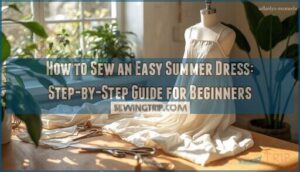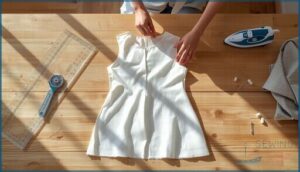This site is supported by our readers. We may earn a commission, at no cost to you, if you purchase through links.
Sticky summer mornings practically dare you to ditch your heavy wardrobe and reach for something easy and breathable. Imagine slipping into a dress you made yourself—a shape you chose, fabric you love, the fit customized to your favorite kind of comfortable. Nothing off-the-rack can compete.
Sewing an easy summer dress isn’t about chasing some elusive “perfect” body or look; it’s about the freedom to express yourself in every stitch, with each curve and fold reflecting your style.
The right pattern, a little know-how, and a few well-chosen materials are all it takes to open up a world of possibility.
Table Of Contents
Key Takeaways
- Choosing a simple, beginner-friendly pattern and taking accurate body measurements are the keys to a flattering, homemade summer dress.
- Opt for lightweight, breathable fabrics like cotton or linen, and don’t skip prewashing to ensure comfort and proper fit.
- Essential tools—like a sewing machine, fabric scissors, and measuring tape—make sewing smoother, while optional upgrades like rotary cutters and dress forms help polish your project.
- Personal touches such as pockets, ruffles, and vibrant fabric choices let you express your style and make each dress uniquely yours.
Choosing an Easy Summer Dress Pattern
The right pattern can make or break your first sewing project, so you’ll want one that won’t leave you tangled in complicated instructions or unusual construction methods. Starting with a straightforward design means you’ll actually finish your dress and feel good wearing it out this summer.
Let’s look at what makes a pattern beginner-friendly, how to nail the sizing, and where to score both free and paid options that won’t intimidate you.
Recommended Beginner-Friendly Patterns
Pattern selection can feel overwhelming, but some dress sewing patterns are perfect for sewing beginners ready to break free from store-bought limits. Here are winning beginner projects:
- Wrap Dress – flattering silhouette with straightforward construction
- Wear Everywhere Easy Knit Dress – just two pattern pieces using forgiving knit fabric
- Tiered Sundress Pattern – relaxed fit with side pockets, no experience needed
- York Pinafore Dress – simple woven design introducing intermediate techniques
For beginners, exploring summer dress patterns can help find the perfect project.
Pattern Size and Fit Considerations
Once you’ve found a pattern you love, taking accurate body measurements becomes your secret weapon. Most dress sewing patterns follow standard pattern grading, but don’t assume you’re a straight size—measure your bust, waist, and hips carefully.
For summer dress construction, bodice fitting matters most. If you’re between sizes during size selection, choose larger and make fit adjustments. Your garment construction techniques will thank you later.
Understanding proper body measurement techniques is essential for a well-fitting dress.
Where to Find Free and Paid Patterns
Once you’ve nailed your measurements, the hunt begins. Pattern Sources like Mood Sewciety and Gathered.how offer Free Dress Patterns, perfect for testing your skills.
Digital Marketplaces and Fabric Retailers host paid Summer Dress Sewing Patterns from Indie Designers and big brands.
Sewing Communities buzz with fresh ideas—don’t be afraid to explore, download, and join the conversation.
Selecting The Best Fabric for Summer Dresses
Picking the right fabric is where your summer dress starts to come alive. You’ll want something light, comfortable, and suited to your style.
Here’s what to keep in mind before you get started.
Lightweight and Breathable Fabric Options
Ever wondered why some summer dresses feel like a cool breeze while others trap heat? It’s all about smart Textile Fabric Selection. Cotton, linen, and bamboo—these Natural Fibers are the backbone of Summer Textiles.
Eco Friendly Fabrics like Tencel offer breathability and comfort. For Sewing for Beginners, choose light Fabric Weights; your Fabric Choice shapes Summer Fashion Trends in every stitch.
How to Choose Prints and Colors
Color Psychology isn’t just hype—it’s your secret weapon in dress making. Lean into Summer Hues like neo-mint or aquatic blues for a fresh vibe; bold prints, wildflowers, or pixelated motifs echo the latest Print Trends.
For Sewing for Beginners, medium-scale prints and vibrant colors make your Summer Dress pop, while Fashion Forecasting guides your confident Fabric Choice every season.
Preparing and Prewashing Fabric
Think of prewashing as your secret handshake with the fabric—an essential ritual in dressmaking. Fabric Shrinkage can sabotage your fit, so proper Fabric Preparation is non-negotiable.
The Prewash Benefits go beyond Textile Care: you’re softening stiff Textile Fabric, setting dyes, and prepping for precise cutting. Follow smart Laundry Tips, and your Summer Dress will hug you just right.
Essential Tools and Materials Needed
Before you start sewing, you’ll want to gather a few key supplies. Having the right tools makes the process smoother and a lot more enjoyable.
Here’s what you’ll need to get your summer dress project off the ground.
Must-Have Sewing Supplies
Ready to dive into summer dress sewing? You’ll need a solid toolkit—think of it as your creative arsenal. Here’s your must-have list:
- Sewing Machine (your main engine for Summer Dress Sewing Patterns)
- Fabric Scissors for crisp cuts
- Measuring Tools for accuracy
- All-purpose Thread Types for durability
- Essential Sewing Notions (pins, bobbins, seam rippers)
Optional Tools for Better Results
Want the upper hand in dress sewing? Tools like Rotary Cutters slice through fabric like butter, while Dress Forms make pattern drafting and fitting a breeze. Add Fabric Glues and specialized Sewing Notions for crisp finishes and fewer slips. These upgrades enhance your skills, making every Summer Dress Sewing Pattern—free or paid—feel like a curated, custom experience.
| Tool | Result |
|---|---|
| Rotary Cutters | Precise, fast fabric cutting |
| Dress Forms | Accurate fit and easy draping |
| Fabric Glues | Quick, neat seam finishing |
Using a Sewing Pattern Fitting Guide Book
Ever wondered why your summer dress pulls at the bust or gapes at the neck? A fitting guide book is your compass.
You’ll master pattern alterations and fitting techniques—no more guessing at sizes or second-guessing your shape. By focusing on measurement accuracy, these guides release sewing confidence, giving you the tools for garment fitting that flatters every curve.
Whether you’re hacking sewing patterns or tackling a fresh dress sewing adventure, you’ll tighten your skills from pattern design to finishing seams.
Step-by-Step Guide to Sewing Your Dress
Ready to start sewing? Here’s what you need to know, from handling fabric to those little touches that make your summer dress stand out.
Let’s walk through each step together.
Cutting Fabric Pieces Accurately
Here’s where your Summer Dress adventure takes shape: precise fabric cutting is everything. Accurate measurements and sharp cutting tools turn your pattern pieces into beautifully fitting realities. For clean lines, follow these essentials:
- Align fabric grain—never trust the selvedge blindly.
- Anchor rulers and use single, smooth motions.
- Always prewash and press before cutting.
Nail these Fabric Cutting Tips, and your dress soars.
Assembling and Sewing Dress Sections
You’ve cut your panels with care—now it’s time to bring those pieces together. Section Assembly is the heart of Dress Sewing. Match notches, watch Fabric Alignment, and respect the Seam Allowance on your Sewing Pattern. Use these techniques below to build like a pro:
| Step | Pro Tip |
|---|---|
| Pin at stress points | Flat felled seams for strength |
| Sew in logical sequence | Start with bodice or skirt |
| Finish raw edges | Try a French seam for sheers |
Adding Features Like Pockets or Ruffles
Once your sundress panels are stitched, it’s time for those personal touches—think pocket placement and ruffle styles. Sewing pockets isn’t just practical, it’s liberating, giving hands-free freedom with every step.
Ruffled dress embellishments add personality, while smart fabric choices guarantee comfort. Explore sewing patterns that offer features you love, and watch your easy summer dress reflect your boldest self.
Tips for a Perfect Finish and Styling
Getting that homemade dress to look and feel just right isn’t just about sewing straight lines. There are a few little tricks and finishing touches that make all the difference.
Here’s how you can give your summer dress that polished, personal feel.
Pressing and Finishing Seams
Between every stage, embrace Seam Pressing as your secret weapon—it’s what nudges dress sewing from homemade to head-turning.
Run your iron over each seam right after stitching, letting that steam set your lines. This touch gives your garment longevity, sharpens your fabric finishing, and guarantees professional finishes in all your summer dress sewing patterns.
Crisp seams? Pure sewing accuracy.
Adjusting Fit for Comfort
Once those seams are pressed flat, it’s time to get hands-on with fit adjustments. Trust your body measurements, not just the sewing patterns. A little ease allowance—one to two inches—means you’ll actually move, breathe, and sparkle in your Summer Dress.
Pin, check comfort factors, and don’t shy away from garment modifications. Dress sewing should always feel like freedom, not restriction.
Sew your dress for comfort and confidence—adjust the fit so it always feels like freedom, never restriction
Styling Ideas for Your DIY Summer Dress
Styling your DIY Summer Dress is where the real magic begins. Immerse yourself in Summer Vibes with bold color blocking, playful fabric choices, and smart dress accessories. This season, try weaving in these staples:
- Layer a denim jacket for cool evenings
- Add metallic sandals for relaxed Summer Fashion
- Experiment with Color Blocking and pastels
- Tie on a straw tote for sunny adventures
Frequently Asked Questions (FAQs)
How do I adjust the dress length for my height?
Don’t let your height hold you hostage—take charge by tweaking your summer dress length. A quick pattern modification here, a hem alteration there, and suddenly your sundress reflects your individuality and body proportions with absolute confidence.
Can I add pockets to the summer dress pattern?
Absolutely, you can add pockets to any summer dress pattern. Clever pocket placement blends function and style—think in-seam or hidden styles.
Your fabric choices and silhouette matter, so match sewing techniques to your favorite summer dress sewing patterns.
What alternatives are there for the bias tape finish?
Who needs bland old bias tape anyway? For summer dress finishing, try a Turned Edge for a sleek result, French Seams for polish, Fold Over elastic for stretch, Serging Stitch for speed, or a crisp Double Fold hem.
How do I modify the pattern for maternity wear?
To modify a Maternity Pattern for belly accommodation, slash and spread the pattern’s front, add fabric stretch panels, and favor an empire waistline—with these maternity hacks, even your favorite summer dress sewing patterns become DIY maternity wear.
How do you care for a finished cotton dress?
Wash your cotton summer dress gently with cold water and mild detergent for fabric softening and stain removal.
Air dry, iron damp for cotton preservation, and store your dress properly on padded hangers to keep it fresh and impeccable.
Can you sew a summer dress without a serger?
You don’t need a serger to sew a summer dress. With Sewing Machines, simple seam finishing options—like pinking shears, zigzag stitches, or DIY techniques—work wonders.
It’s all about smart Fabric Choices and creative Serging Alternatives with modern Sewing Patterns.
What are common mistakes when sewing summer dresses?
Skipping fabric selection basics or ignoring pattern fitting? That’s how sewing errors happen. Think uneven seams, distorted shapes, and droopy hems.
Mix up good pattern cutting with crisp seam finishing, and your DIY Dress goes from flop to fabulous.
How long does it take to sew a simple dress?
On average, beginner-friendly summer dress patterns take about 6 to 12 hours to sew, but your fabric selection, pattern complexity, and sewing skill level all factor in.
Carefully manage your time, and you’ll finish your sundress confidently.
Can summer dresses be made from recycled fabrics?
Summer dresses can be crafted from recycled fabric types like PET bottle polyester and blended cotton.
Choosing these eco-friendly textiles weaves sustainable fashion into your DIY dress, supporting the circular economy and green sewing practices with every stitch.
Conclusion
Maybe tomorrow’s muggy sunrise will nudge you to sew an easy summer dress that’s nothing like the ready-made versions cluttering your closet.
The first time your stitches meet sunlight, you’ll realize you’re not just learning a skill—you’re claiming a bit of creative freedom for yourself.
Let instinct guide your fabric choices, embrace beginner mistakes, and trust that your hands know more than you think.
Your dress will become a wearable secret: comfort sewn with courage, and every inch entirely yours.
- https://www.moodfabrics.com/blog/the-rosalie-shirt-dress-free-sewing-pattern/
- https://www.diydaisy.com/blog/maya-ruffle-dress-top-tutorial
- https://www.instagram.com/stories/highlights/17852103950035030/
- https://so-sew-easy.com/something-sweet-something-racy/
- http://www.create-enjoy.com/2014/06/DIY-Jcrew-scallop-dress-tutorial-organic-cotton.html













